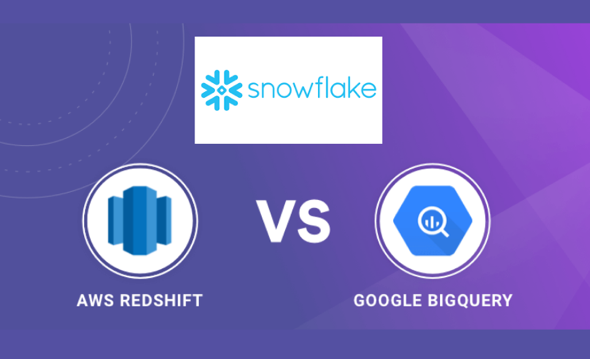Redshift vs Google BigQuery vs Snowflake

The virtual landscape of Data Engineering is once again undergoing renovations in 2021. As more businesses migrate to the digital space, use of BI tools are vital to comb unstructured data. It is a constant challenge as computing benchmarks change frequently making top solution providers like Google BigQuery, Redshift and Snowflake in demand. Comparison is inevitable between them. It all depends on specific requirements of an organization rather than mere dependency of any available cloud software products.
Which of the above service providers support the best ETL or warehousing needs with their advanced solutions?
The genesis
| Snowflake | Google BigQuery | Redshift |
| Ideal for scalable and flexible storage of data | Highly storable engine. It can also scale independently | Data access is through configured firewall rules |
| Entirely built for cloud and operates on Amazon S3 cloud structure | Provision for multiple data cloud warehouses from the same data | Computing and storage facilities are combined. All resources are on a single platform |
| Subscription model for BI | Supports authenticated models with a service account | Requires periodic cleaning of data and constant analysis |
| Provides compatible SQL-format and end users need not manage it | Delivers encryption in transit and niche group access to cloud accounts | It is a fully managed service with a technical expert form Amazon |
| Supports multi-cloud users. Access is controlled through IP | Role-based access control. Provides end-to-end encryption | |
| Is enabled to communicate to other private clouds | Low maintenance and less performance capabilities | Shared-nothing parallel processing architecture |
| All clusters are linked to a central hub to process data | Google has a system to scale storage automatically. As data increases so does the capacity to store | The parallel processing is similar to other systems like Netezza and Greenplum |
| Looking for concurrency? Then Snowflake is the best solution | Scalability makes it a go-to solution for big companies and e-commerce | Ideal for standard database and dedicated admin |
The ultimate showdown: Pricing depends on usage

| Snowflake | Google BigQuery | Redshift |
| Proprietary cache system which also works on hybrid. It is similar to c-store and MonetDB | Distributed computing which runs on Borg | Par Accel fork running on AWS virtual systems |
| In-memory SD, columnar aggressive metadata cache | Storage layer on Colossus file system | Contains hot query and metadata cache |
| Has a compression layer. Reduces computing costs by scanning less data | Compresses data continuously | Open Algorithms are used for compression based on enquiry |
| In transit or at rest encryption. More features available with higher pricing plans | Encryption via KMS or CMEK | AWS key management system for dedicated servers |
| ANSI compliant and ideal for all operations | Query languages- Legacy, SQL and standard SQL | ANSI, SQL Syntax, addition of geo spatial data |
Companies wishing to migrate data on cloud can choose any of the top three solutions depending on data access requirement. Does a solution fit the bill? Ask for professional assistance to deploy any of these products. Hands-on experience in data engineering and usage demands prior consultancy for any enterprise. You may wish to know more about streaming, data sources enquiry and access control in depth. Consultancy includes tips on data sharing and maintenance to avoid loss of vital information.
